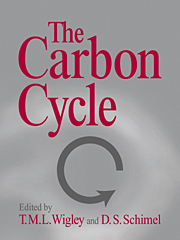Book contents
- Frontmatter
- Contents
- Preface
- Acknowledgments
- Contributors to the 1993 Global Change Institute
- I INTRODUCTION
- II THE MISSING CARBON SINK
- 3 Carbon Dioxide Emissions from Fossil Fuel Consumption and Cement Manufacture, 1751–1991, and an Estimate of Their Isotopic Composition and Latitudinal Distribution
- 4 Emissions of Carbon from Land-Use Change
- 5 The CO2 Fertilizing Effect: Relevance to the Global Carbon Cycle
- 6 Soils and the Global Carbon Cycle
- 7 Grasslands and the Global Carbon Cycle: Modeling the Effects of Climate Change
- 8 Constraints on the Atmospheric Carbon Budget from Spatial Distributions of CO2
- 9 Estimating Air–Sea Exchanges of CO2 from pCO2 Gradients: Assessment of Uncertainties
- 10 Atmospheric Oxygen Measurements and the Carbon Cycle
- 11 A Strategy for Estimating the Potential Soil Carbon Storage Due to CO2 Fertilization
- III PALEO-CO2 VARIATIONS
- IV MODELING CO2 CHANGES
- Part V Appendixes
- Index
7 - Grasslands and the Global Carbon Cycle: Modeling the Effects of Climate Change
from II - THE MISSING CARBON SINK
Published online by Cambridge University Press: 04 December 2009
- Frontmatter
- Contents
- Preface
- Acknowledgments
- Contributors to the 1993 Global Change Institute
- I INTRODUCTION
- II THE MISSING CARBON SINK
- 3 Carbon Dioxide Emissions from Fossil Fuel Consumption and Cement Manufacture, 1751–1991, and an Estimate of Their Isotopic Composition and Latitudinal Distribution
- 4 Emissions of Carbon from Land-Use Change
- 5 The CO2 Fertilizing Effect: Relevance to the Global Carbon Cycle
- 6 Soils and the Global Carbon Cycle
- 7 Grasslands and the Global Carbon Cycle: Modeling the Effects of Climate Change
- 8 Constraints on the Atmospheric Carbon Budget from Spatial Distributions of CO2
- 9 Estimating Air–Sea Exchanges of CO2 from pCO2 Gradients: Assessment of Uncertainties
- 10 Atmospheric Oxygen Measurements and the Carbon Cycle
- 11 A Strategy for Estimating the Potential Soil Carbon Storage Due to CO2 Fertilization
- III PALEO-CO2 VARIATIONS
- IV MODELING CO2 CHANGES
- Part V Appendixes
- Index
Summary
Abstract
The potential effects of climate change on grassland carbon budgets have received much less attention than those on forests. Changes in productivity and soil carbon need to be addressed, as well as the role of grassland burning in the global carbon cycle. Under a recent Scientific Committee on Problems of the Environment (SCOPE) collaborative project, we analyzed the sensitivity of global grassland ecosystems to modified climate and atmospheric CO2 levels, concentrating on ecosystem dynamics rather than redistribution of grasslands. Worldwide, 31 grassland sites, temperate and tropical, were modeled under doubled-CO2 climates projected by two different general circulation models. Results for climate change alone (without CO2 effect) indicate that simulated soil C losses occur in most grassland regions, ranging from 0 to 14% of current soil C levels for the surface 20 cm. Direct CO2 enhancement effects on decomposition and plant production tended to reduce the net impact of climate alterations alone. Detecting all these impacts will require a minimum of 16% change in net primary production and a 1% change in soil carbon. It is unclear whether grassland carbon stocks will increase overall under the new regimes, since changes in land use and biome area probably will result in a net source of carbon.
Introduction
Grassland ecosystems are far from uniform. They support myriad different species, both above and below ground, and are crucial in maintaining the ecological balance of a large part of the world, supporting diverse human and animal populations.
- Type
- Chapter
- Information
- The Carbon Cycle , pp. 102 - 114Publisher: Cambridge University PressPrint publication year: 2000
- 5
- Cited by

